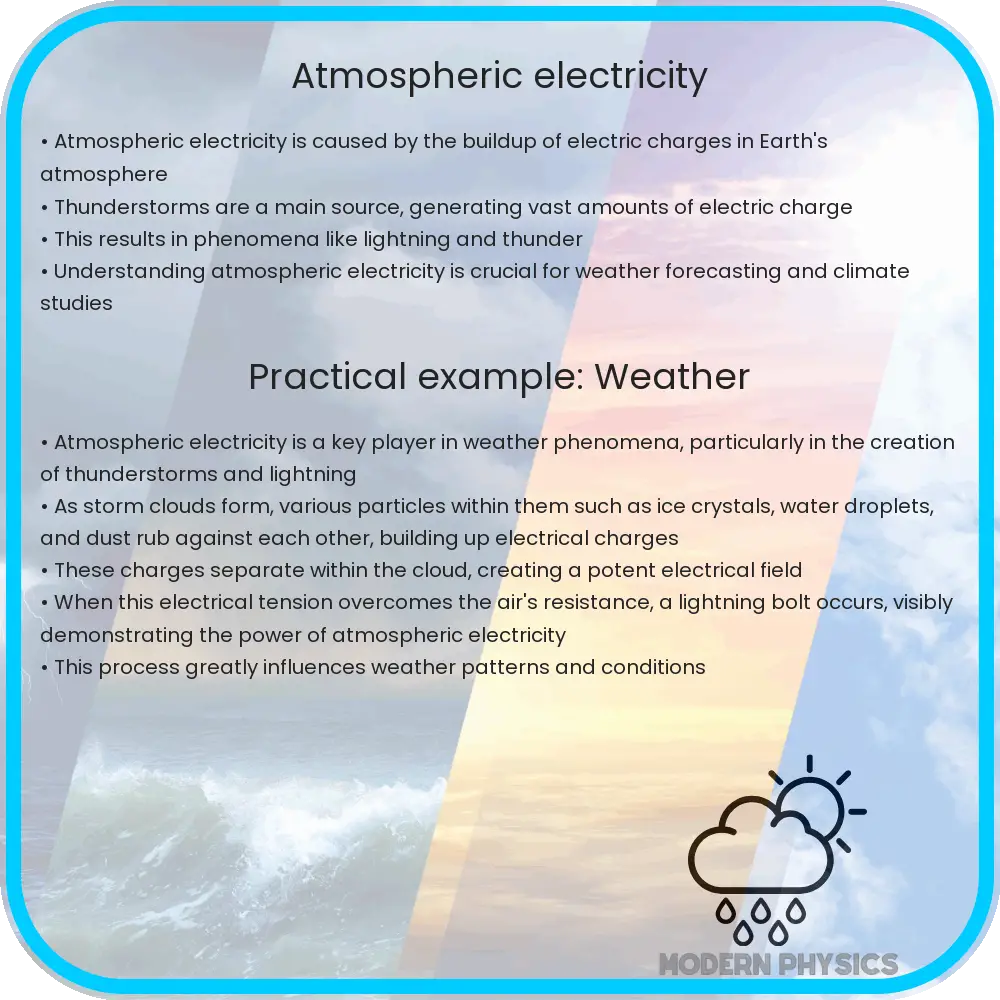Atmospheric electricity encompasses the study of electrical phenomena in Earth’s atmosphere, including lightning and auroras.

Unlocking the Secrets of Atmospheric Electricity
Atmospheric electricity is a fascinating field of study concerned with the electrical charges, currents, and processes that occur in the Earth’s atmosphere. This branch of atmospheric science seeks to understand how and why our planet’s atmosphere carries an electric charge, and how this phenomenon influences both the environment and our daily lives.
The Mysteries of Atmospheric Electricity
One of the most captivating phenomena related to atmospheric electricity is the aurora borealis, or northern lights. This spectacular display of colors and lights in the sky is a result of charged particles from the sun colliding with atoms in Earth’s upper atmosphere. Researchers are continually studying these interactions to enhance our understanding of geomagnetic storms and solar wind impacts.
Another intriguing aspect of atmospheric electricity is thunderstorm electrification. Scientists are still unraveling the detailed mechanisms that cause a thunderstorm to develop strong electrical fields, leading to lightning. The current understanding involves the separation of positive and negative charges within storm clouds. As particles within the cloud move and collide, lighter, positively charged ice crystals rise to the top, while heavier, negatively charged particles sink, creating an intense electric field within the cloud that can lead to lightning.
- Cloud-to-ground lightning: This spectacular phenomenon occurs when a strong negative charge at the base of a thundercloud connects with a positive charge on the ground.
- Intra-cloud lightning: More common than cloud-to-ground, this type of lightning occurs between different charged areas within the same cloud.
- Cloud-to-cloud lightning: This involves the exchange of charges between different clouds.
Impact on Human Activity and Technology
The influence of atmospheric electricity is broad and varied. One of its most direct impacts is on aviation safety. Lightning strikes can damage aircraft structures, disrupt electronic navigation systems, and pose serious risks to flights. Moreover, electrical phenomena in the atmosphere affect the operation of satellites and space stations, particularly through the event known as “space weather.
On the technology front, atmospheric electricity also plays a crucial role in the functioning of radio communications and the behavior of the Earth’s magnetic field, which are pivotal for navigation and communication technologies. Additionally, improving our understanding of atmospheric electricity can enhance climate modeling and predictions by incorporating electrical aspects of thunderstorms and other meteorological events.
Current Research and Technological Advancements
Scientific research into atmospheric electricity has evolved dramatically with technological advancement. Satellites, high-altitude balloons, and sophisticated ground-based sensors are increasingly used to collect data. This helps in creating models and simulations that predict weather patterns, climate change impacts, and the behavior of electrical phenomena in the atmosphere more accurately.
Researchers are particularly interested in how changes in the global electrical circuit are indicative of changes in the climate. Innovations in monitoring and measurement technologies offer valuable insights into the complex interactions between the sun’s activity and Earth’s atmospheric conditions.
Educational and Public Safety Applications
Understanding atmospheric electricity is not only critical for scientists but also holds significance for education and public safety. Educational programs that incorporate basic principles of atmospheric electricity can enhance public awareness and understanding of weather phenomena, potentially increasing interest in Earth sciences among students. For public safety, accurate knowledge and timely communication of electrical phenomena can lead to better preparedness for severe weather events.
For instance, community alert systems and mobile apps utilize data on atmospheric electrical activity to warn residents about impending lightning storms or severe weather conditions, giving them ample time to seek safety.
Conclusion
Atmospheric electricity is a compelling branch of science that offers profound insights not only into how our planet functions but also how we interact with our environment. From the stunning visual displays of the aurora borealis to the practical applications in aviation safety and weather forecasting, the study of atmospheric electricity is relevant and crucial. While much about atmospheric electricity remains a mystery, ongoing research and technological advancements hold the promise of deepening our understanding and improving our ability to predict and mitigate its effects. This continuous evolution in the field encourages a future where we can coexist more harmoniously with the natural electrical phenomena of our world, safeguarding our technological assets and enhancing our responsiveness to environmental challenges.
